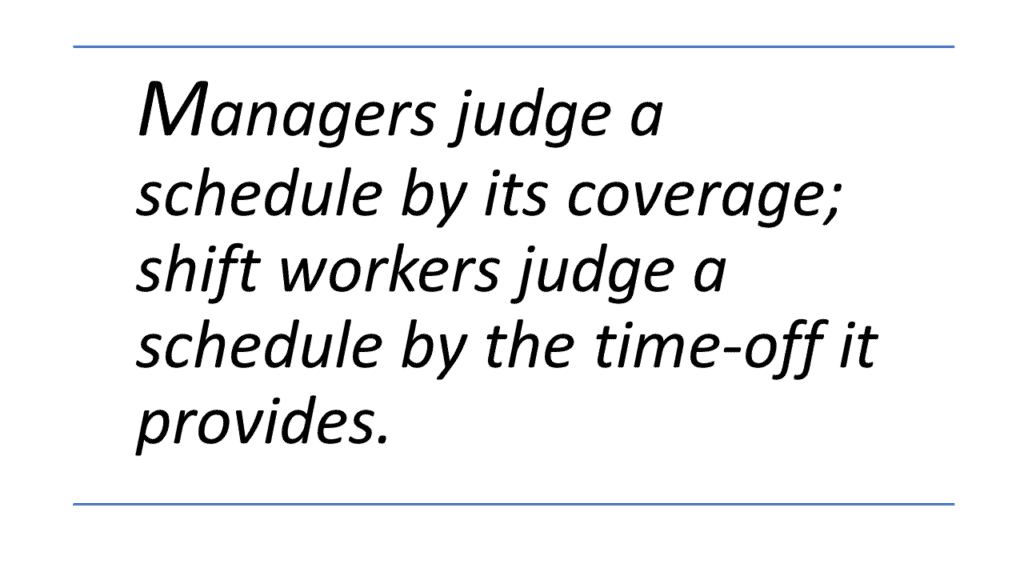by Jim Dillingham, Partner, Shiftwork Solutions
It’s amazing how something that looks so simple can be so hard. After all, what could be easier? Just post a new schedule on the bulletin board and implement it on Monday. Or post a couple of schedules and let the workers choose the one they want. How could anyone object to that?
Many managers are perplexed when something as simple as changing shift schedules causes so much strife among the workforce. The best place to start is with an understanding of the underlying issues.
A significant effort is usually required to identify the type of schedule that will satisfy the business requirements. Once this daunting task has been accomplished, the biggest challenge still remains. How do you get widespread support for the new schedule?

One factor increasing the complexity is that managers and workers look at the schedule from different perspectives. Show a copy of a shift schedule to a group of managers and they will immediately check whether the schedule provides all of the coverage their operation requires. Hand out the same schedule to a group of shift workers and they will begin to do things like count their weekends off, calculate the best times for vacation, see who works on Christmas, etc. Managers judge a schedule by its coverage; shift workers judge a schedule by the time-off it provides.
A second (and more significant) difficulty is that the shift workers will not agree on what a good schedule is. Beauty really is in the eye of the beholder. A shift schedule that one worker believes is perfect may spell disaster for another. Some managers believe (or hope) that since everyone works at the same site doing the same work, they should all be comfortable with the same type of shift schedule. Unfortunately, it just doesn’t work that way.

Shift workers have strikingly different lives away from work. Some have second jobs and some are students. There are single parents and people with civic, religious, or social organization responsibilities. Think of the variety of activities your people participate in, such as youth sports coaches, bowlers, hunters, skiers, golfers, etc. If you have 500 shift workers, they will have 500 different uses for their time off. Because of the diversity of activities, responsibilities, and interests, some will want to have lots of time off each day while others will prefer more full days off. You will find some who want partial weekends off (if they have to work a weekend at all), and others who would rather work full weekends so they can have full weekends off at another point in the schedule. The bottom line is that when you change a shift schedule, you impact the lifestyles of your workforce, and because of the diversity of lifestyles, not everyone will be affected in the same way.
Consider these before deciding about the new schedule
Still want to change schedules? Keep the following three principles in mind, and you will go a long way towards smoothing the transition:
- Clearly define the business case for changing the schedule. Among the drivers can be changing demand or customer requirements, organizational or cultural change, new business imperatives (such as new strategic direction), or technology improvements. You don’t want to change schedules if you don’t have to ― once you make the change, you want to be sure it was the right one (or you get to do it again later!).
- Communicate with the workforce. Tell them why and when things are going to happen. Left in an information vacuum, the workforce may perceive that the schedule change is arbitrary, or “management is out to get us”.
- Actively seek input from the shift workers. Use a methodology that allows everyone to have input before the change takes place. Be careful not to pay a disproportionate amount of attention to the few individuals who claim to speak for everyone else. In most cases, they are speaking for themselves.
Consider these before introducing the new schedule
Once you know what the new schedule is going to be, it’s time to think about how you’re going to handle the following considerations:
- How will current pay and work practices be affected? Mistakes are long-lived, even when corrected. Once you give something away, it’s difficult to take it back. Vacations, shift differentials, bereavement, and holidays are a few of the policies that will need to be reviewed.
- When are you going to implement it? Small changes can be implemented quickly while major ones (e.g., going from 5 to 7 days of coverage) may require giving the workforce several weeks to prepare. Certain times of the year are better for implementation than others. For example, it is probably not a good idea to change schedules in the middle of the holiday season.
- Resource assignment: who will be assigned to what shift? Skill balance and length of service are the types of issues that need to be considered. This is an especially “hot topic” for a fixed shift operation.
- What will the overtime policies look like? Even if overtime levels remain unchanged with the new schedule, the distribution of the overtime may be different. For example, on an 8-hour schedule, overtime is typically worked by coming in before or staying after the normal shift; on a 12-hour schedule, overtime is usually worked on a day off.
Changing schedules can be a rough ride. That’s why a lot of companies decide not to proceed and may forego the potential business benefits of a schedule change – often measured in $M. If you and your management team are committed to making the change, follow the three principles and take the four considerations listed above into account. You’ll be glad you did, and so will the rest of the company.
Call Us and We Can Help
Call or text us today at (415) 763-5005 to discuss your operations and how we can help you solve your shift work problems. You can also complete our contact form and we will call you.
